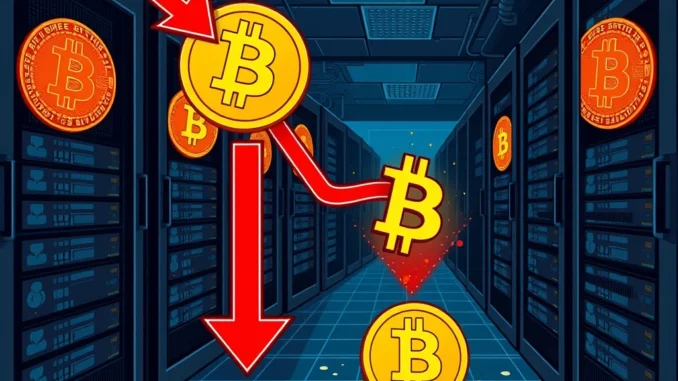
Is the recent dip in Bitcoin price just a minor setback, or are we looking at a deeper correction? A crucial indicator suggests we might be facing further downward pressure: Bitcoin miners are starting to sell off their holdings. This isn’t just speculation; recent data highlights a significant uptick in Bitcoin miners transferring their BTC to exchanges. Let’s dive into what this means for the market and what you need to watch out for.
Why Are Bitcoin Miners Increasing Selling Pressure Now?
Bitcoin miners play a vital role in the cryptocurrency ecosystem. They are the backbone of the network, responsible for validating transactions and securing the blockchain. However, mining is a resource-intensive operation, demanding significant investments in hardware and electricity. When the price of Bitcoin declines, as we’ve seen recently with BTC nearing local lows, miners often face increased financial strain. To cover their operational costs – electricity bills, equipment maintenance, and potentially loan repayments – they sometimes resort to selling their mined Bitcoin.
This behavior isn’t new. Historically, during price downturns, Bitcoin miners tend to liquidate more of their BTC holdings. CryptoQuant contributor IT Tech recently pointed out this trend, noting a surge in BTC transfers from miner wallets to exchanges following the price drop to around $77,700. This action immediately introduces more selling pressure into the market.
Understanding Miner Selling Pressure: Key Factors
Several factors contribute to why miner selling can exert significant selling pressure on the Bitcoin market:
- Operational Costs: Mining is expensive. When Bitcoin prices fall, miners’ profit margins shrink, making it necessary to sell BTC to cover expenses.
- Market Sentiment: Price drops often trigger fear and uncertainty in the broader market. Miner selling can amplify this negative sentiment, potentially leading to further sell-offs by other investors.
- Liquidity: Miners typically hold large amounts of Bitcoin. When they start selling, it can inject a substantial amount of BTC into the market, increasing supply and potentially driving prices down if demand doesn’t keep pace.
- Hedging Strategies: Some miners might engage in hedging strategies to protect themselves against further price declines. Selling Bitcoin on exchanges can be part of such strategies.
BTC Price Nears Local Lows: A Cause for Concern?
The recent dip in BTC price to around $77,700 has understandably caused some unease in the crypto community. While Bitcoin is known for its volatility, sustained downward pressure can lead to deeper corrections. The increased selling activity from miners adds another layer of complexity to the current market situation.
Is this dip just a temporary blip, or a sign of a more significant downturn?
While it’s impossible to predict the future with certainty, the miner selling data suggests caution. If buyer demand remains weak and fails to absorb the increased supply from miners, we could indeed see further downside for Bitcoin. This doesn’t necessarily mean a crash, but it does indicate that the path to recovery might be bumpy.
Impact on the Crypto Exchange Market
The increased transfer of Bitcoin to crypto exchanges by miners has a direct and immediate impact on the exchange market dynamics. When miners deposit BTC onto exchanges, they are essentially signaling their intention to sell. This influx of Bitcoin supply on exchanges can lead to:
- Increased Supply: More BTC available for sale on exchanges naturally increases the overall supply.
- Potential Price Drop: If demand doesn’t match the increased supply, the basic economic principle of supply and demand suggests that prices could decline.
- Volatility Spike: Increased selling pressure can contribute to higher price volatility in the short term.
- Market Correction: In a broader context, sustained selling pressure can contribute to a market correction, where prices adjust downwards to find a new equilibrium.
Traders and investors closely monitor crypto exchange flows to gauge market sentiment and potential price movements. Large inflows of Bitcoin to exchanges, especially from miner wallets, are often interpreted as a bearish signal.
Navigating the Market Dip: Actionable Insights
So, what should you do amidst this increased selling pressure and market dip? Here are a few actionable insights:
- Stay Informed: Keep a close eye on market data, including miner flows to exchanges, on-chain analytics, and overall market sentiment.
- Manage Risk: Consider adjusting your portfolio risk. If you are risk-averse, you might want to reduce your exposure to Bitcoin or cryptocurrencies in the short term.
- Dollar-Cost Averaging (DCA): For long-term investors, market dips can present buying opportunities. Dollar-cost averaging involves investing a fixed amount of money at regular intervals, regardless of the price. This strategy can help mitigate the risk of buying at market peaks.
- Diversification: Ensure your portfolio is well-diversified. Don’t put all your eggs in one basket. Consider spreading your investments across different asset classes.
- Fundamental Analysis: Look beyond short-term price fluctuations and focus on the long-term fundamentals of Bitcoin and the broader crypto market. Are the underlying drivers of growth still intact?
The Road Ahead for Bitcoin
The current situation with Bitcoin miners increasing selling pressure is a reminder of the inherent volatility and cyclical nature of the cryptocurrency market. While increased miner selling can contribute to downward pressure in the short term, it’s important to remember that the long-term trajectory of Bitcoin and the crypto market is influenced by a multitude of factors, including technological advancements, adoption rates, regulatory developments, and macroeconomic conditions.
The key takeaway? Market corrections are a normal part of the cycle. Understanding the dynamics of miner behavior and selling pressure can help you navigate these periods more effectively. By staying informed, managing risk, and focusing on the long-term potential of Bitcoin, you can position yourself to weather the storms and potentially capitalize on future opportunities in the ever-evolving world of cryptocurrency.



